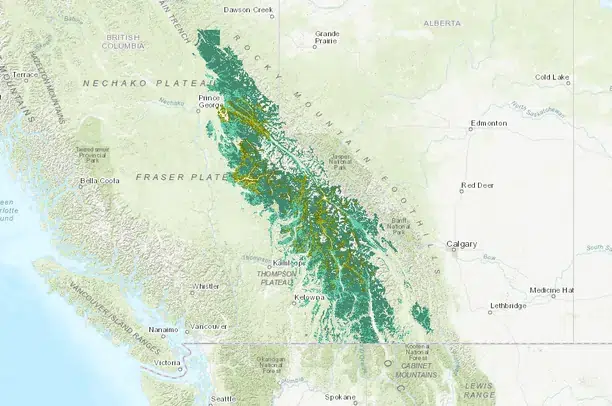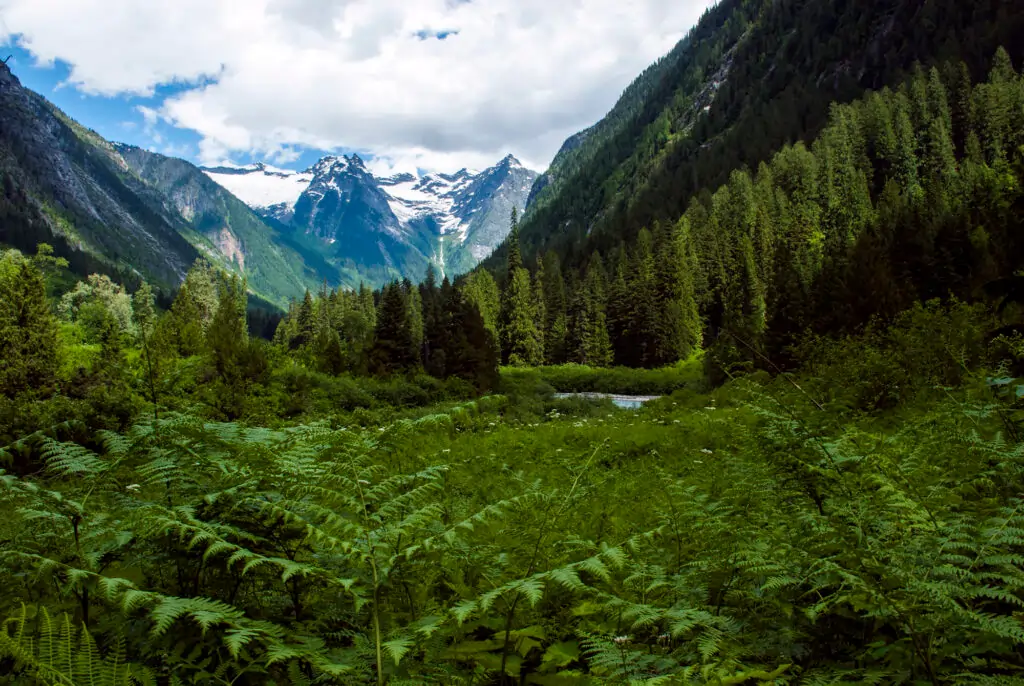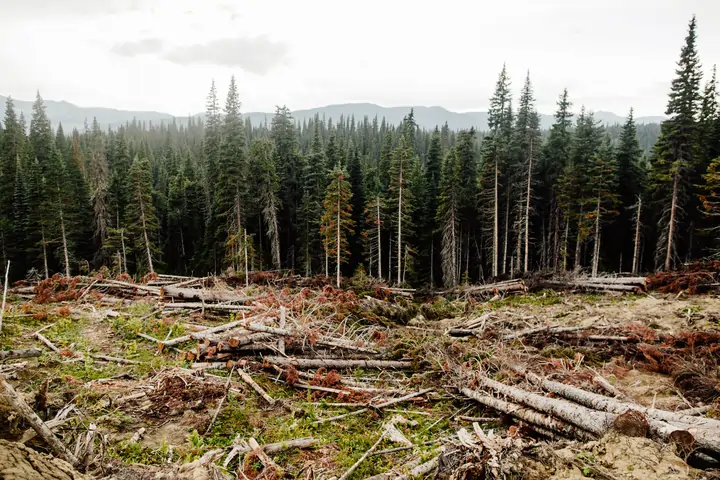Introduction
Imagine stepping into a lush, green world where ancient trees tower above and rare wildlife thrives—welcome to British Columbia’s Inland Temperate Rainforest. This unique ecosystem captivates the senses and ignites curiosity.
Located in the heart of British Columbia, this temperate rainforest is one of the world’s rarest and most ecologically significant regions. It boasts diverse flora and fauna adapted to its unique climatic conditions.
Exploring British Columbia’s Inland Temperate Rainforest offers insights into an ecosystem both a natural wonder and a critical component of global biodiversity. Its preservation is vital for the local environment and understanding the broader impacts of climate change and human activity on such delicate habitats.
Read also: Ecosystem | Definition, Components, and 5 Important Types of Ecosystem
This article examines the unique characteristics of British Columbia’s Inland Temperate Rainforest, its ecological significance, and its challenges, highlighting the urgent need for conservation efforts.
Understanding and appreciating British Columbia’s inland temperate rainforest is essential for recognizing its role in biodiversity conservation, climate regulation, and cultural heritage. This underscores the importance of protecting this irreplaceable ecosystem.
The article will cover the rainforest’s unique features, biodiversity, threats, and conservation measures implemented to protect it, providing a comprehensive overview of this remarkable ecosystem.
This detailed outline for the introduction sets the stage for a captivating and informative exploration of British Columbia’s Inland Temperate Rainforest, emphasizing its significance and the necessity for its preservation.
Introduction to British Columbia’s Inland Temperate Rainforest
The inland temperate rainforest ecosystem covers 40 million acres. It extends over 1100 km from central Idaho to Prince George, British Columbia, creating a globally rich, unique, and vast landscape. It is renowned for its plant life, vast ecology, and unique wildlife, providing a biodiverse environment. The climate, which is calm and soothing, helps many species survive. Interpretation and safeguarding of this rainforest are essential in protecting its ecological integrity and offerings to the planet.
Read also: Biodiversity Crisis: 5 Shocking Ways We’re Losing Nature’s Riches
Read also: Rainforest Food Web: Brutal or Beautiful? Explore the Jungle’s Hunger Games
Geographic Location
British Columbia’s Inland temperate rainforest is situated in the central interior of British Columbia, Canada, extending towards the western slopes of the Columbia and Rocky Mountains. This unique rainforest covers several regions, including Robson Valley, the Cariboo Mountains, and some parts of the Monashree Mountains. It is nearly linked to the North Central Rockies forest designed by the World Wildlife Fund. Initially, it was recognized from the coastal Pacific temperate rainforest going towards Washington state up to Southcentral Alaska.

Read also: Canadian Shield: Rugged Beauty and Unexpected Riches Within
Read also: Formation of the Rockies: The 5 Geological Events For The Massive Upheaval
Why Called ‘Inland’?
Inland refers to places far away from the coast or shoreline, frequently towards the interior of a country or region. This term is mainly utilized to describe land at a specific distance from huge bodies of water. This rainforest is found in the interior of British Columbia, hence the name inland rainforest.
Climate
The climate of the British Columbia inland temperate forest is humid, with a heavy downpour, soothing temperatures, and sometimes snowfall. This unique climate assists the growth of lush vegetation, including cedar and hemlock trees, and increases biodiversity.
It is known as a temperate forest because of its high precipitation levels and humid conditions, similar to those of the coasts’ rainforests. The constant rainfall helps grow lush vegetation, ancient trees, and many plant and animal species, similar to those of tropical and temperate rainforests.
Biodiversity
Flora
Lodgepole pine was the first species to dominate the rainforest, and the primitive strands were dominated by western red cedar. Western red cedar and hemlock are the most common tree species in low-elevation inland rainforest patches. Engelmann spruce and red alder thrive in high-altitude rainforests.
Read also: Animals of North America: 20 Astonishing Creatures You Must Discover
Fauna
British Columbia’s Inland Temperate Rainforest is home to many animals, including carnivores and herbivores, including black bears, grizzly bears, etc. The most specific area in the forest includes mountain caribou, also known as woodland caribou, even though it is currently endangered by the US Fish and Wildlife Services. The hotter temperatures have made British Columbia’s inland temperate forests home to many animals, such as moose, deer, and elk, increasing predators.
Read also: Discover 5 Thriving Secrets about Forest Food Web
Ecological Significance of British Columbia’s Inland Temperate Rainforest
British Columbia’s inland temperate forests play a significant role in maintaining ecological balance and biodiversity. Many flora, fauna, and animals live outside inland temperate forests, where the dense and rich canopy forest provides various species with the required habitat and food resources.

The primitive forest and the trees are required for maintaining the rainforest for water quality and regulation. This even encourages complex food webs and assists in soil formation and nutrient cycling. In this forest, there is competition, negotiation, and symbiotic relationships between trees, plants, and fungi.
Read also: Why is Food Web Important? Types of Food web
Read also: Soil Formation Process: 1 Glimpse From Rock to Rich Earth
Latest Scientific Research Findings of the Forest
Recent findings from researchers at the University of Northern British Columbia and international collaborators reveal that the core areas of this rainforest are facing challenges of collapsing due to immense logging. It has also been discovered that the primary forest areas have declined by up to 95 percent since 1970.
Threats and Conservation Efforts
Threats to British Columbia’s Inland Temperate Rainforest
- Current challenges that the British Columbia Inland Temperate Rainforest faces are logging, mining, and the development of hydroelectric projects, along with climatic changes.
- The inland forest is at high risk of being cleared out.
- In addition, in British Columbia, the establishment of hydroelectric projects threatens the operation of forests and other riparian ecosystems.
- Climatic changes, especially the snowfall during winter and the average yearly temperature are gradually increasing, creating havoc for the British Columbia Inland Temperate Forests.

Read also: Open-Cast Mining: Profit at the Expense of Our Environment
Read also: Climate Change | 7 Alarming Effects and the Major Causes Behind
Conservation Efforts to British Columbia’s Inland Temperate Rainforest
- Conservation Projects are not particularly taken, but the government is taking measures to catalyze these areas using conservation area design (CAD) techniques.
- Expanding protected areas and other reserves to protect habitats from logging and development helps maintain the rainforest’s biodiversity.
- Certification programs like the Forest Stewardship Council to make sure that the logging is done properly.
- Adding strict environmental regulations to prevent logging and destruction of ecology.
Conclusion
British Columbia’s Inland Temperate Rainforest is a fine example of nature’s grandeur and complexity. With its rich biodiversity and ancient trees, this unique ecosystem is a natural marvel crucial to global environmental health. The exploration of this rainforest reveals its ecological significance and the pressing need for conservation efforts amidst growing threats from climate change and human activities.
Read also: Cultural Differences Between Canada and the USA: 5 Unexpected Contrasts
Studying its unique characteristics, biodiversity, and the challenges this temperate rainforest faces, we gain a deeper appreciation for its value and the urgent need to protect it. This article will give a vast understanding of British Columbia’s Inland Temperate Rainforest, emphasizing its importance and the constant efforts to preserve this irreplaceable natural treasure.
Call to action
Protect British Columbia’s Inland Temperate Rainforest! Join us in preserving this unique ecosystem by supporting local conservation efforts and spreading awareness. Share this article, visit the rainforest responsibly, and contribute to organizations dedicated to its protection. Together, we can ensure the survival of this natural treasure for future generations.
FAQs
1. What is unique about British Columbia’s inland temperate rainforest?
British Columbia’s inland temperate rainforest is unique due to its location far from coastal influences, creating a rare ecosystem in only two other places globally. It features ancient cedar and hemlock trees, rich biodiversity, including rare lichens and mosses, and various wildlife like grizzly bears and wolverines. The rainforest’s high moisture levels and consistent rainfall support its lush vegetation and complex ecosystems (UNBC) (The Narwhal) (UNBC).
2. Why is the inland temperate rainforest at risk of collapse?
The inland temperate rainforest is at risk of collapse primarily due to extensive logging practices that have significantly reduced old-growth forest areas. Since 1970, clearcut logging has led to a 70% to 95% decline in core old-growth areas, disrupting habitats and making species that rely on these forests critically endangered. The ecosystem could collapse within nine to 18 years if logging practices do not change.
3. What conservation efforts are being made to protect British Columbia’s inland temperate rainforest?
Conservation efforts include establishing protected areas like the Ancient Forest/Chun T’oh Whudujut Provincial Park, promoting sustainable forestry practices, conducting scientific research and monitoring, and engaging local communities and First Nations in conservation initiatives. Reforestation and habitat restoration projects also play a crucial role, along with advocacy for stronger environmental regulations and policies to prevent further degradation.
4. How does the inland temperate rainforest contribute to global biodiversity?
The inland temperate rainforest contributes to global biodiversity by hosting a wide array of species, many rare or unique to this ecosystem. Recent studies have discovered over 2,400 species in the region, including new mosses, lichens, and vascular plants. This biodiversity supports complex food webs and ecological interactions, making the rainforest a vital component of the global ecosystem.
5. What are the economic and ecological impacts of losing the inland temperate rainforest?
Losing the inland temperate rainforest would have significant economic and ecological impacts. Economically, it would affect industries like tourism and forestry that rely on the forest’s resources. Ecologically, it would lead to the loss of critical habitats, declining biodiversity, disrupted water cycles, and increased carbon emissions due to the loss of carbon-storing old-growth trees. The overall health and stability of the region’s environment would be severely compromised.
6. How can individuals contribute to conserving British Columbia’s inland temperate rainforest?
Individuals can contribute by supporting conservation organizations, advocating for stronger environmental policies, participating in reforestation projects, and raising awareness about the importance of the inland temperate rainforest. Making sustainable choices in daily life, such as reducing carbon footprints and supporting sustainable products, also helps. Visiting the rainforest responsibly and educating others about its significance can further promote its conservation.
References
- BC’s inland temperate Rainforest. (n.d.). Wildsight. Retrieved May 28, 2024, from https://wildsight.ca/programs/bcs-inland-temperate-rainforest/
- Wikipedia contributors. (2023, May 9). North American inland temperate rainforest. Wikipedia, The Free Encyclopedia. https://en.wikipedia.org/w/index.php?title=North_American_inland_temperate_rainforest&oldid=1153900200
- BC’s rare inland temperate Rainforest. (2021, March 2). Valhalla Wilderness Society. https://www.vws.org/projects/inland-temperate-rainforest/bcs-rare-inland-temperate-rainforest/

